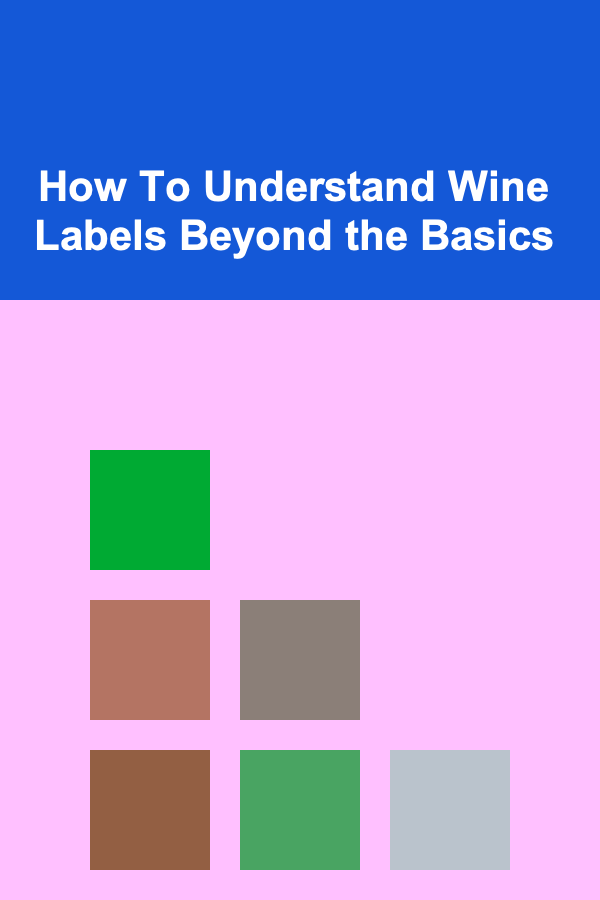
How To Understand Wine Labels Beyond the Basics
ebook include PDF & Audio bundle (Micro Guide)
$12.99$6.99
Limited Time Offer! Order within the next:

Understanding wine labels is essential for anyone who wants to navigate the world of wine with confidence. While most people can identify basic information like the wine's name, producer, and vintage, there's far more to a wine label than meets the eye. A deeper understanding of wine labels can elevate your wine knowledge and appreciation, enabling you to make informed decisions when purchasing wine and appreciating the complexities of each bottle.
In this article, we will dive into the nuances of wine labels beyond the basics, exploring the key elements that make up a wine label, their significance, and how they can help you enhance your wine-tasting experience. We will also explore the meaning behind various terms and classifications that may not be immediately obvious, providing a guide to understanding wine labels more thoroughly.
The Anatomy of a Wine Label
A wine label typically includes several pieces of information, ranging from the most obvious (like the wine's name and brand) to more intricate details that provide insight into the wine's origins, production methods, and quality.
Let's break down the essential components of a wine label:
1.1 Producer Name
The name of the producer is usually one of the most prominent pieces of information on a wine label. This can be a well-known winery, a small family estate, or a corporate brand. The producer's reputation often serves as a marker of quality, especially in regions where certain estates have a long-standing history of producing exceptional wines.
- Example: Château Lafite Rothschild, a renowned Bordeaux estate.
- Why it matters: Some producers are known for their expertise and consistency, making their wines a reliable choice for consumers seeking quality.
1.2 Wine Name
The wine's name may appear alongside the producer's name. Sometimes, the wine's name is straightforward (such as "Château Lafite Rothschild," named after the estate), but other times, it might be a unique, creative title reflecting a particular blend or style.
- Example: The "Vieux Telegraphe" wine from Domaine du Vieux Télégraphe in Châteauneuf-du-Pape, which reflects a traditional naming system.
- Why it matters: The name often reflects the wine's heritage, style, and sometimes its regional or vineyard-specific identity.
1.3 Vintage
The vintage refers to the year in which the grapes were harvested. This is a critical detail because the weather conditions during the growing season heavily influence the quality and characteristics of the wine. A vintage year may be particularly memorable due to exceptional weather, while another may be less favorable.
- Example: 2015 Napa Valley Cabernet Sauvignon.
- Why it matters: Knowing the vintage allows you to compare wines from different years and understand how the climate impacted the wine. It also provides a sense of a wine's ageability.
1.4 Grape Variety (Varietal)
Wine labels often include the grape variety or varieties used in the wine. This is especially common in New World wines like those from the United States, Australia, and South America. In the Old World, it's less common for the varietal to be listed, as wines are often named based on the region or appellation rather than the grape.
- Example: A "Chardonnay" wine made from the Chardonnay grape.
- Why it matters: The grape variety determines a large part of the flavor profile, body, and aroma of the wine. It's important to know the grape when you want to match wines to food or explore particular styles.
1.5 Appellation
The appellation is a geographical region where the wine is produced, often governed by strict rules that define what can and cannot be included in the wine. Appellations can be large regions, like Bordeaux, or small, specific areas, like Meursault in Burgundy.
- Example: "Bourgogne" (Burgundy) or "Napa Valley."
- Why it matters: The appellation can tell you a lot about the wine's characteristics, as each region has distinct growing conditions, terroir (the influence of geography, geology, and climate), and winemaking traditions that shape the wine's style and quality.
1.6 Alcohol Content
The alcohol by volume (ABV) is an important detail on the wine label, as it gives you an idea of the wine's strength and body. Wines with a higher ABV tend to be fuller-bodied and more intense, while wines with lower ABV are often lighter and more delicate.
- Example: A wine with an ABV of 13.5% indicates a moderate alcohol level.
- Why it matters: The ABV can help you decide the wine's style. For example, a dessert wine might have a higher ABV, while a light white wine or rosé is typically lower.
1.7 Wine Classification Terms
Certain wine labels feature classifications that can be important for quality and style. These classifications may refer to a wine's quality, specific vineyard sources, or its aging potential. Common classification terms include:
- Grand Cru / Premier Cru (Burgundy): Refers to wines made from the best vineyards in Burgundy.
- Reserva / Gran Reserva (Spain): In Spain, these terms indicate aging requirements, with Gran Reserva wines requiring extended aging before release.
- Cru Classé (Bordeaux): Wines from vineyards classified as "cru classé" in Bordeaux are considered to be of high quality.
1.8 Additional Information: Serving Temperature, Pairings, and Sustainability Labels
Increasingly, wine labels are incorporating additional information to enhance the consumer experience. This includes suggested serving temperatures, food pairings, and sustainability certifications such as "organic," "biodynamic," or "sustainable."
- Example: A label that says "Best served at 16°C" or "Pairs well with grilled meats."
- Why it matters: These details can guide you in selecting wines that will pair well with your meal or be enjoyed at the optimal temperature.
Understanding Terms That Go Beyond the Basics
While the above sections focus on the core elements of a wine label, there are numerous other terms that may appear on a wine label that are worth exploring. These terms often reflect the wine's production process, quality indicators, and provenance. Here are a few key ones to watch for:
2.1 Terroir
"Terroir" refers to the unique combination of environmental factors, including soil type, climate, and topography, that affect the character of the wine. Although terroir is not always explicitly mentioned on a label, it is deeply ingrained in the identity of many wines, especially those from regions like Burgundy, Champagne, and Bordeaux.
- Example: A wine from "Côte d'Or" in Burgundy may be associated with the rich terroir of the area.
- Why it matters: Terroir influences the flavor and character of the wine, making it an important consideration for wine enthusiasts.
2.2 Appellation d'Origine Contrôlée (AOC)
This French term is a certification given to certain wines from specific regions, ensuring that they meet stringent production and quality standards. It guarantees that the wine comes from a particular area and follows the rules associated with that region.
- Example: "AOC Chablis" means the wine is from the Chablis region in Burgundy and follows AOC standards.
- Why it matters: AOC status guarantees a certain level of quality and authenticity, helping you trust the origins and production methods of the wine.
2.3 Estate Bottled
An "Estate Bottled" wine means that the wine was produced and bottled by the winery that owns the vineyards from which the grapes were harvested. This term assures consumers that the winery has control over every aspect of production, from grape growing to bottling.
- Example: A wine labeled as "Estate Bottled" may be more expensive but is likely to reflect the specific quality and style of that vineyard.
- Why it matters: Estate bottled wines are often seen as higher quality because of the winery's direct control over the production process.
2.4 Organic and Biodynamic Wines
Organic wines are made from grapes grown without synthetic pesticides or fertilizers. Biodynamic wines take this a step further, incorporating holistic farming practices that treat the vineyard as a self-sustaining ecosystem. These wines are increasingly popular with consumers who are concerned about environmental sustainability.
- Example: A label might say "Certified Organic" or "Biodynamic Wine."
- Why it matters: These labels appeal to consumers who are conscious of their ecological impact and seek wines that are produced using sustainable, natural methods.
How to Interpret Wine Labels for Better Wine Choices
Understanding wine labels is a skill that can enhance your wine experiences. Here are some tips on how to interpret these labels to make more informed wine choices:
3.1 Learn About the Region
Start by learning about the major wine regions of the world. Different regions are known for producing certain types of wines due to climate, soil, and traditions. For example, you'll often find Chardonnay in Burgundy and Napa Valley, and Cabernet Sauvignon is a signature grape of Bordeaux and California's Napa Valley.
3.2 Pay Attention to Quality Indicators
Look for quality indicators such as AOC, DOC, or Grand Cru classifications, as these labels signify higher levels of quality and compliance with local winemaking standards.
3.3 Trust Your Own Tastes
Ultimately, wine is about personal enjoyment. While learning about wine labels and classifications can enhance your understanding, it's most important to trust your own palate. If you enjoy a particular style, whether it's a specific grape variety or wine from a particular region, let that guide your choices.
Conclusion
Wine labels hold a wealth of information that goes far beyond the basics. By understanding the different components of a wine label and learning the meanings behind various terms, classifications, and regional specifics, you can significantly improve your wine knowledge and enhance your ability to make informed wine choices. Whether you are selecting a bottle for dinner or exploring a new wine region, understanding wine labels will allow you to appreciate the complexity and artistry behind each bottle.
Incorporating this knowledge into your wine-buying process will open up a world of possibilities and help you make more educated, enjoyable decisions when exploring the vast world of wine.

Best Organization Tools for Nonprofit Organizations
Read More
How to Add Custom Shelving to Maximize Space in Your Home
Read More
How to Keep Your Bathroom Clean with Minimal Products
Read More
How to Maximize Bedroom Storage Without Sacrificing Style
Read More
Why an Organized Kitchen Makes Cooking Easier
Read More
10 Tips for a Daily Pilates To-Do List for Beginners
Read MoreOther Products

Best Organization Tools for Nonprofit Organizations
Read More
How to Add Custom Shelving to Maximize Space in Your Home
Read More
How to Keep Your Bathroom Clean with Minimal Products
Read More
How to Maximize Bedroom Storage Without Sacrificing Style
Read More
Why an Organized Kitchen Makes Cooking Easier
Read More